Livewells for Bass Boats
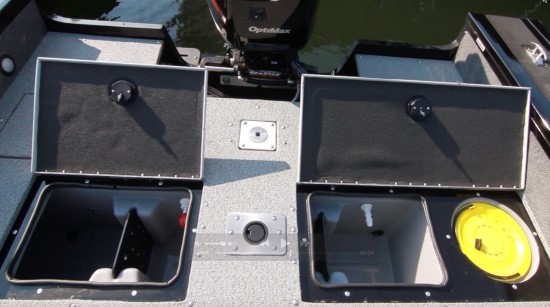
Livewells for Bass Boats
While the gleaming gelcoats, racing-style seats and high-horsepower outboards of modern bass boats attract the attention in showrooms, it's what's belowdecks that's most important to serious tournament anglers, and there's no part of the boat more important to them than the “livewell.”
Livewells. Most bass boat livewells are designed for largemouth, smallmouth and spotted bass, not for bait. Tournament rules require fish to be delivered to weigh-in alive or the competitor loses points, so keeping the fish lively can mean thousands of dollars won or lost -- to say nothing of the conservation aspect.
Predictably, according to pro bass anglers, bass boat wells that are larger and deeper do better than those that are smaller and shallower.
Not only does the greater volume of larger wells provide more breathing room for the fish, it also reduces chances of them getting banged into the walls of the well as the boat runs down the lake at 70 mph, as these boats do with some frequency. The wells are located under the aft deck in performance bass boats, since that's where they carry the weight best in their pad-hull designs.
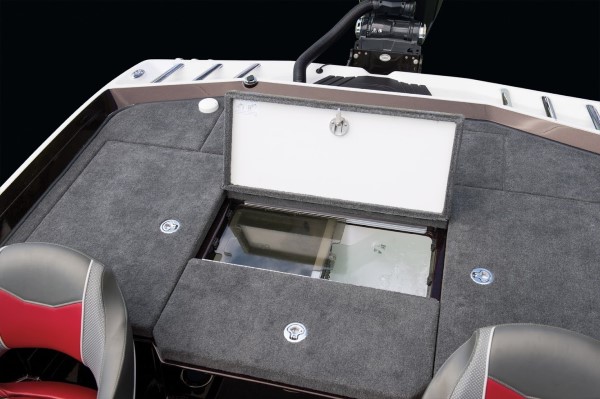
Larger boats have the space for larger wells, naturally -- the Ranger Z522, which is 22'5" (6.83 m) long, for example, has a 31-gallon (117 L) well in the aft deck. The Ranger Z518, 18'8" (5.69 m) long, on the other hand, has a 24-gallon (91 L) well. While both can keep bass lively, in tough conditions where there's a limit of large fish in the well or when temperatures are high, the larger well will do better. (Legend, apparently the king of the livewell race, has a 47-gallon/178 L model in its V21.)
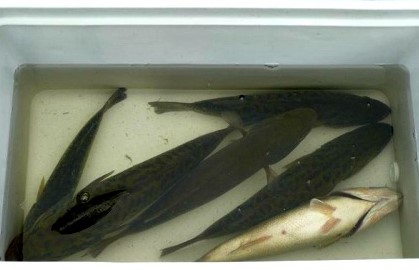
Well Dividers. Bass wells often have a removable divider that allows separating the fish in the well, useful in some tournaments where a second angler sits aft and fishes for separate prizes against other rear-seaters. The divider is normally removed if no second angler is competing, allowing more room for a single limit of fish and adding survivability.
How Much to Pump? Wells with high-volume water pumps and powerful aerators do a better job than those with weaker pumps and aeration, within limits. Pumps used in bass boat livewells typically range from 600 to 800 gallons per hour (GPH). The better ones also have easily replaceable cartridge-type components that allow repairing the pump in minutes, without dealing with the plumbing.
Consumer Caveat. Note that there are also bilge pumps that look much like livewell pumps, with capacities to 2,000 gph, way too big for a bassboat livewell because they would buffet the fish and probably flood the boat as they overwhelm the overflow pipes.
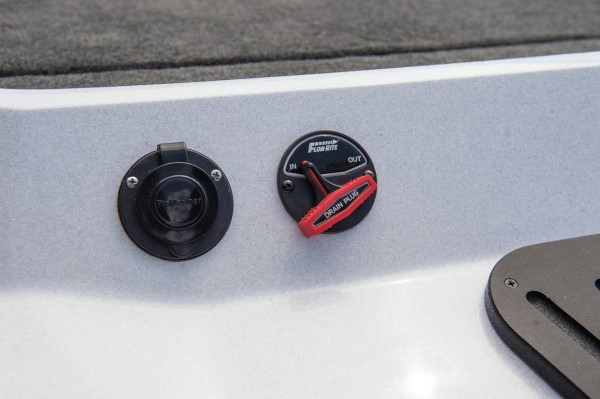
Recirculation. Most bass boats also have the capability of "recirculating" the water that's pumped into the well, with aeration, which allows the boat to be run at high speed or hauled on a trailer without losing the water in the well. It also allows keeping poor-quality water outside the well when the boat pulls into an enclosed harbor where spilled fuel, high temperatures, or low oxygen levels are likely. This flow is controlled from a remote switch, with an adjustable timer that allows the aerator pump to run intermittently.
The closed system also allows cooling the water by adding frozen water bottles, or adding oxygen from a tank system or an electronic generator, greatly increasing survival potential for the fish.
Baitwells for Multi-Species Boats
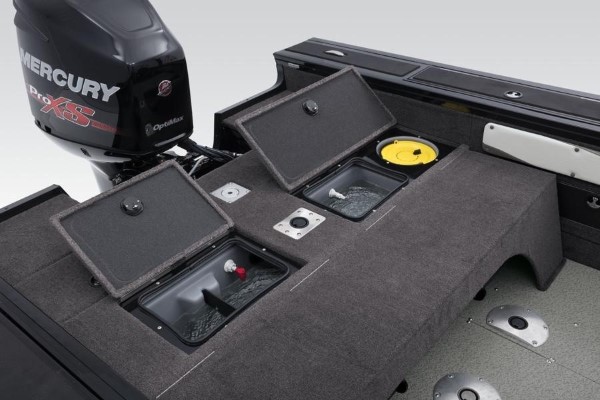
Anglers in the market for walleye/multi-species boats used primarily in northern and upper Midwest lakes may need a well to hold a tournament catch of walleyes, but these anglers also frequently fish live bait and so need added capacity to keep that bait fresh and lively.
Many brands add a removable bait bucket to the aerated livewell, allowing the main aeration/pump system to serve both. The wells are typically rotomolded composite, with rounded corners to prevent fish from stacking up and ceasing to maintain equilibrium.
An LED waterproof light allows anglers to keep tabs on the health of their catch. Since walleyes to 30" (.76 m) long are possible catches, the wells tend to be made longer than those found in bass boats, where the fish are more compact.
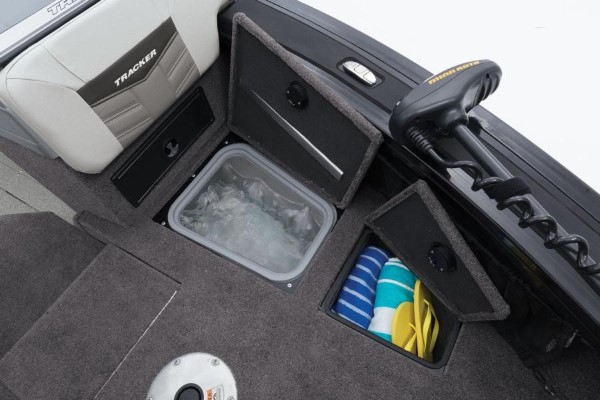
The Tracker Targa V-19, an all-welded dual console design typical of the genre, has a huge 48-gallon well with a lift-out bait bucket aft plus an added 19-gallon baitwell forward, both with recirculation systems and pumpouts. Dual 750-GPH fill pumps assure plenty of clean water, and dual 500 GPH aerators put plenty of oxygen in the water. Insulation is sprayed around the outside of these wells to help them stay cool, an important factor, as we will see below.
Keeping Things Cool
Biologists tell us that cooler water reduces the metabolic rate of fish, and it also holds more oxygen than warmer water. By cooling the water in a livewell, anglers can improve survival of fish. Filling the well first thing in the morning when the water is coolest is always a good idea. And on hot afternoons, adding ice to the well may be essential.
However, adding ice directly to the well is not a good idea. Most commercial ice is made from chlorinated water, and when it melts, the chlorine goes into the livewell water. Chlorine is a poison to fish.
A Good Cooling Technique. However, frozen 16-ounce water bottles do a good job of cooling most wells without danger of infusing chlorine into the water. Simply drop a couple into the well anytime water temperature is above 75 degrees for bass, or 64 for walleyes, replacing every few hours as the ice melts with more frozen bottles from your ice chest.
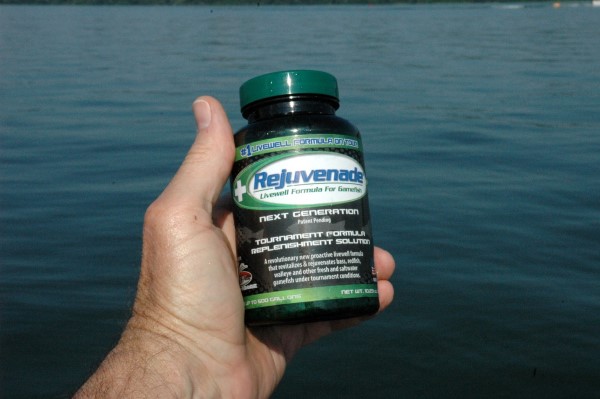
Just Add Salt. There is also considerable evidence that adding non-iodized salt to recirculating livewells keeps fish lively. B.A.S.S., the nation's best-known bass tournament organization, suggests adding 1/3 cup per 5 gallons of water to do the job. There are also commercial live well salts with other additives designed for the same purpose. (Standard table salt is iodized--it will kill fish.)
Well Cleanout
Well care can also be important. The slime and excretions of the fish, as well as regurgitated food, not uncommon when they're stressed in captivity, can turn livewells into bacteria farms harmful to fish and bait. Spray the wells out thoroughly after each use, drain completely and store with the lids open so that they will dry before the next trip.
A few drops of bio-degradable soap can help get rid of odors, but be sure to rinse repeatedly to get out all traces of the soap before you use the well next time. Using bleach in the well is risky -- even when rinsed repeatedly, traces of the chlorine can kill sensitive species.
Well cleanout is even more important in areas where invasive mussels are present -- the larvae are often transported in live wells, but thorough clean-drain-dry procedures prevent the issue. Note that in some lakes, you are required by law to perform this cleanout before leaving the ramp. (Cleaning stations are provided at these locations.)